 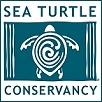 |
Dr. Lew Ehrhart and Dean Bagley (University of Central Florida) succeeded in attaching a satellite transmitter to track the movement of immature green turtles from the 70-90 cm size class. Juvenile greens in this size class are rarely seen by researchers in Florida’s waters and are rarely found stranded. Essentially this size class of green sea turtles is missing from the data. Researchers believe that when this size class of green sea turtles is encountered, they are nearly ready to leave the central east coast of Florida and travel to the next level of developmental habitat, which may be the adult foraging grounds for some of them. Researchers are now trying to find out where these turtles are by using satellite telemetry.
The nearshore and inshore waters of Florida’s central east coast provide optimal habitat for endangered juvenile green turtles, Chelonia mydas, and threatened immature loggerheads, Caretta caretta. The U.C.F. Marine turtle Research group began studying marine turtles in these waters in 1975 and is now involved in three long-term studies (in the central region of the Indian River Lagoon, over nearshore Atlantic Sabellariid worm rock reefs, and in the Trident Submarine Turning Basin at Pt. Canaveral). Upon returning to nearshore waters from a pelagic existence, it appears that juvenile green turtles move through several developmental habitats before reaching adult foraging grounds at or near maturity. Turtles originally tagged in U.C.F. study sites have been recaptured in Cuba, Belize and in Nicaragua, some within a relatively short time, others up to 13 years later. Learning when these movements or migrations occur is as critical to our understanding of sea turtle life history as learning migratory destinations.
For more information on sea turtles, check out the Sea Turtles Information section of our website.
Click on the turtle’s name to see a map of its movements.
| 2005 Turtles | |
| CHARLIE – “Charlie”, named for Charles Gordon Witherington. He was a prominent Central Florida entomologist. During the latter 1950s, his research at the Medical Entomology Lab in Vero Beach, Florida was at the forefront of mosquito control using impoundments and played a large role in making coastal Florida a habitable place. He founded, and until 1992 owned and ran, Falcon Termite and Pest Control in Orlando. He retired in 1992 and one of his sons took over the business. “Charlie” is a 70.0 cm green turtle captured at the St. Lucie Power Plant. The satellite transmitter was attached and the turtle released from Walton Rocks Beach on October 20, 2005. Transmitter attachment was so much easier with the help of Mike Bresette and Ed de Maye. | 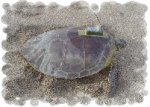 |
| CHAPMAN – “Chapman” was named for Frank Chapman, noted ornithologist and mammalogist. He was the Associate Curator of Mammals and Birds and later Curator of Birds at the American Museum of Natural History. He spent time in Melbourne Beach at Oak Lodge, where he encouraged “Ma” Lathan to document the development of sea turtle hatchings from that beach. Also during his stays at Oak Lodge he discovered and named several small mammals including the Florida Mouse. Chapman was instrumental in helping Paul Kroegel in his efforts to get Pelican Island designated as the first National Wildlife Refuge in the world in 1903. He founded Audubon Magazine and came up with the original idea for the Christmas Bird Count. “Chapman” was released just south of the St. Lucie Power Plant at Walton Rocks on December 26, 2005. Many thanks to Dave Singewald of the St. Lucie Power Plant for his help with transmitter attachment. |  |
| COLUMBUS – “Columbus”, named for Christopher, who discovered the new world. “Columbus” is a 75.2 cm green turtle captured at the St. Lucie Power Plant. The turtle was released on November 4, 2005 from Walton Rocks Beach after transmitter attachment. Transmitter attachment was conducted by Mike Bresette, Karrie Singel and Meghan Conti. Thanks ya’ll! | 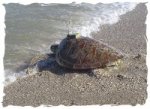 |
| JENNIFER – “Jennifer” is a green turtle who was first captured on October 10, 2002, off the west coast of Bermuda at a site named the Vixen (32.30725 N, 64.8880 W). She was captured in a 2000-ft entrapment net as part of the Bermuda Turtle Project, a joint research project of the Bermuda Aquarium and the Caribbean Conservation Corporation. The turtle measured 62.8 cm straight carapace length at the time she was captured and weighed 36.2 kg. Unlike many of the turtles captured as part of the project, she was seen on only one occasion. The site where Jennifer was originally tagged is a shallow grass bed that serves as a feeding area for green turtles. Nearly 2,500 green turtles have been captured, tagged and released as part of the Bermuda Turtle Project since it began in 1968. Another green turtle tagged in Bermuda stranded dead at Jupiter Inlet in September 2002. Jennifer was later net captured on September 26, 2005 by the sea turtle research team at the St. Lucie Power Plant on Hutchinson Island Florida (about 40 miles north of West Palm Beach). Jennifer measured 67.2 cm straight carapace length and weighed 40.3kg. Jennifer had some problems though; her front flippers had minor constriction wounds and there was a small piece of nylon rope protruding from her cloaca (ouch!). The turtle was picked up by personnel from Florida Marine Research Institute and transported to SeaWorld for rehabilitation. After her brief stint in rehab the turtle was returned to the research team at the power plant on October 5, 2005. The team at the power plant knew that this was a unique turtle and notified Dean Bagley of the University of Central Florida, who conducts studies on the migration routes of green turtles in this size class. We were able to obtain special permission, thanks to Meghan Conti (Florida Fish and Wildlife Conservation Commission) and successfully attached a satellite transmitter to her carapace before releasing her just south of the power plant at Walton Rocks on October 5, 2005. Jennifer is named for Jennifer Gray of the Bermuda Aquarium, who heads the Bermuda Sea Turtle Project along with Anne and Peter Meylan. Thanks to Carly and Ed de Maye and Mike Bresette for their help with the transmitter attachment. |
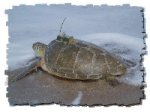 |
| HUBBLE – “Hubble” is named for Edwin Hubble. Hubble developed the idea of the universe and provided the first evidence for the Big Bang theory, which described the birth and evolution of the universe. He discovered the cosmos, and in doing so founded the science of cosmology. The Hubble telescope is named in his honor. Our “Hubble” is an 82.3 cm green turtle captured at the St. Lucie Power Plant. A satellite transmitter was attached on November 27, 2005 prior to release at Walton Rocks Beach. Transmitter attachment was a breeze with the help of Mike Bresette. |  |
| THOR – “Thor” for Thor Heyerdahl, the Norwegian anthropologist noted for his studies of cultural diffusion and leader of the Ra Expeditions. The Kon-Tiki expedition was to demonstrate that South American natives could have traveled to Polynesia. Ra II was used to float from western Africa to the West Indies to show how early seafaring people may have traveled to the Americas long before Columbus. “Thor” is a 72.8 cm green turtle captured at the St. Lucie Power Plant. After a satellite transmitter was attached, he was released at Walton Rocks on November 22, 2005. Transmitter attachment was made easier with the help of Ed de Maye and Dave Singewald. | 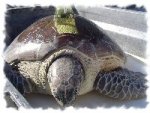 |
| 2004 Turtles | |
| ANNIE – Annie was captured on December 6, 2004 at the St. Lucie Power Plant. Annie is a large green turtle of a size class not seen by the UCF group in nearly 30 years of netting. Records at the St. Lucie Power Plant show that they have captured only about 10 of these large turtles over the years and that none of them have ever been recaptured. She was a big, beautiful green turtle, measuring 83.5 cm straight carapace length. In keeping with the UCF tradition of naming our satellite-tracked green turtles after explorers or scientists, we had to think of someone pretty special for whom to name this turtle. Bruce Peery, who caught the turtle, also suggested who that should be. She was named “Annie” after Dr. Anne Meylan, a FWC Biologist and Sea Turtle Researcher, who has been and continues to be an inspiration to us all. |  |
| 2002/2003 Turtles | |
| BARTRAM – After receiving a call from the St. Lucie Power Plant saying that they had just captured a turtle large enough for a transmitter down there, UCF researchers headed south to the power plant. Bartram is the largest transmittered turtle in our study thus far, at 74.4 cm. Mike Bresette and Rick Herren assisted with the attachment. We finished at about 8:45 that night and left him quietly awaiting his release. We went to Melbourne for the night and returned in the morning to release Bartram into the Atlantic at about 11 a.m. on Jan 31, 2003. | 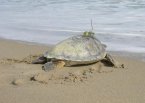 |
| DARWIN – Darwin (after Charles Darwin) was first captured November 11, 2002 in Indian River Lagoon and released November 12, 2002 just south of Sebastian Inlet in the Indian River Lagoon. This turtle might be the largest we have sat tagged. She measured 69.5 but both pygals had been broken off at some time earlier, so she could have been up to 72 cm or larger. Researchers are very excited about her migration! She might have settled down just north of Card Sound Road at the north end of Key Largo. |  |
| JACQUES – Jacques was one of 38 juvenile green turtles captured in the Indian River Lagoon (IRL) by the UCF group on 14 Feb. Transmitter was attached and turtle was released back into the IRL just south of Sebastian Inlet on Feb 15, 2003 at 8:30 a.m. |  |
| WALLACE – Wallace was originally captured in 1996 in the Indian River Lagoon and has been recapped 3 times since. She is one of the longest in-residence lagoon turtles that researchers know of (6 years). She was originally caught during my study which showed her to be female. Wallace has remained in the same general area, but because the barrier island is so narrow and the accuracy of the hits are not exact, researchers cannot tell if she’s inside or outside. | |
| WALLY – Wally was a cold stunned turtle from the Jan 25-26, 2003 cold stun episode at Mosquito Lagoon. Sea turtles, like other cold blooded reptiles, can be affected by sudden drops in temperature. Sea turtles become lethargic and disorientated in extreme cold water, making it hard for them to swim and surface to breathe. The cold-stunned turtles were brought to the Merritt Island Wildlife Refuge (INWR) facility and held for 4 days until the water was warm enough to release on Thurs, 30 Jan. Stacy Kubis, Tomo Hirama and Dean Bagley went to MINWR to do the attachment after a phone call from Karen Holloway-Adkins of the Dynamac/NASA group (Jane Provancha, Mario Mota). The transmitter was attached and all of the cold stunned turtles including Wally were taken into Mosquito Lagoon with the help of the USFWS. |
 |
| 2001 Turtles | |
| CORONA – Corona, a 70.2 cm long juvenile green turtle, was captured in the nearshore worm rock reef south of the Sebastian Inlet (Indian River County, FL) on June 1, 2001. The turtle was captured in a large mesh tangle net as part of long-term population ecology studies. Corona was carefully examined to make sure that it was in good health and had no flipper damage of any kind. Corona was flipper tagged, measured and weighed before the satellite transmitter was attached. |  |
| GULLIVER – Gulliver, a 70.2 cm long juvenile green turtle, was captured in the nearshore worm rock reef south of the Sebastian Inlet (Indian River County, FL) on June 8, 2001. The turtle was captured in a large mesh tangle net as part of long-term population ecology studies. Gulliver was carefully examined to make sure that it was in good health and had no flipper damage of any kind. Gulliver was flipper tagged, measured and weighed before the satellite transmitter was attached. |  |
| PHINNEAS – Phinneas, a 70.5 cm long juvenile green turtle, was captured in the Indian River Lagoon south of the Sebastian Inlet (Indian River County, FL) on November 11, 2001. The turtle was captured in a large mesh tangle net as part of long-term population ecology studies. Phinneas was carefully examined to make sure that it was in good health and had no flipper damage of any kind. Phinneas was flipper tagged, measured and weighed before the satellite transmitter was attached. |  |
 |
The 2004 Florida Juvenile Green Turtle Tracking Project was funded by a grant awarded from the Sea Turtle Grants Program. The Sea Turtle Grants Program is funded from proceeds from the sale of the Florida Sea Turtle License Plate. Learn more at www.helpingseaturtles.org |
 |
Funding for the 2002/2003 Florida Juvenile Green Turtle Tracking Project and the Sea Turtle Migration-Tracking Education Program was provided by the Disney Wildlife Conservation Fund. |